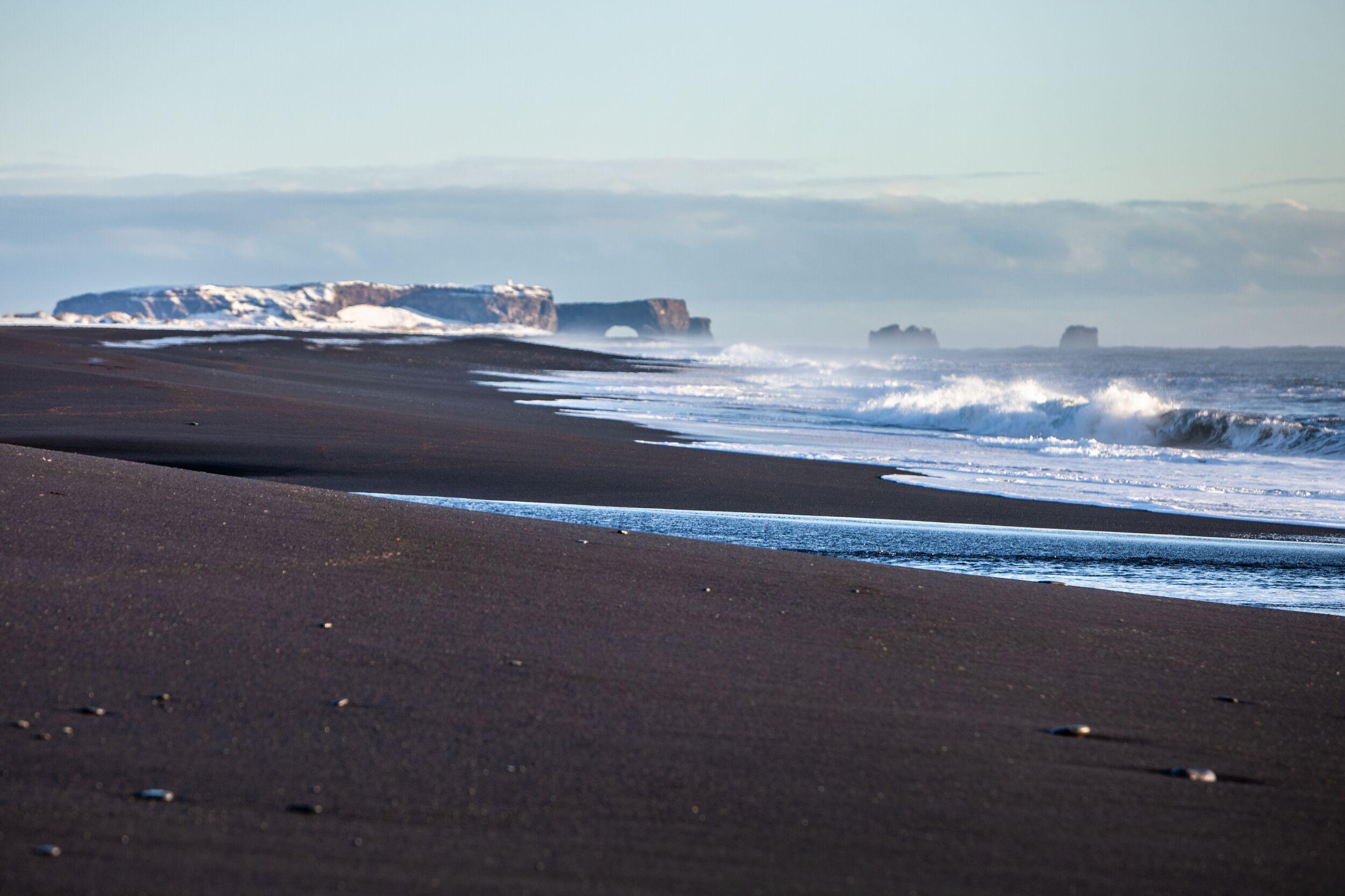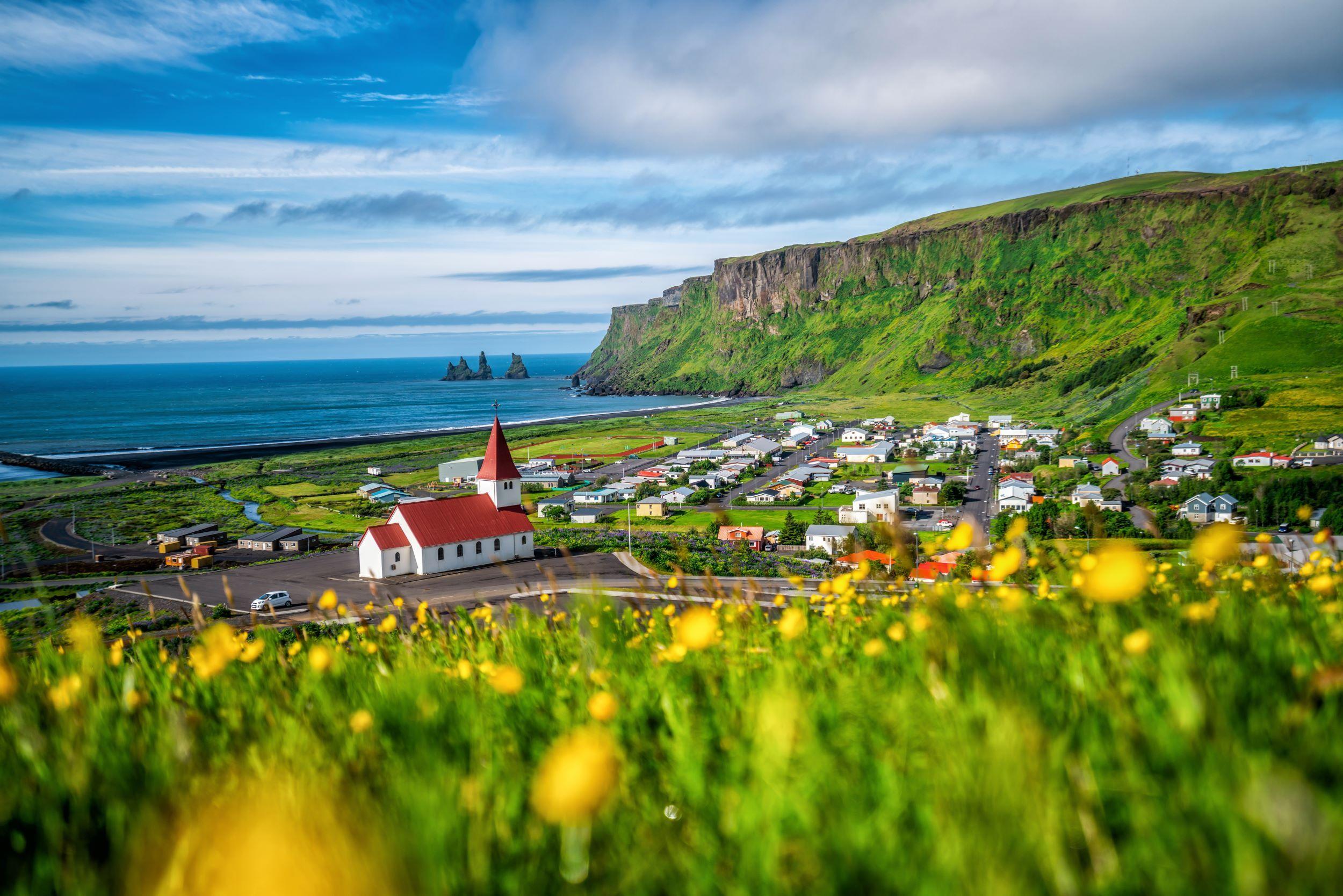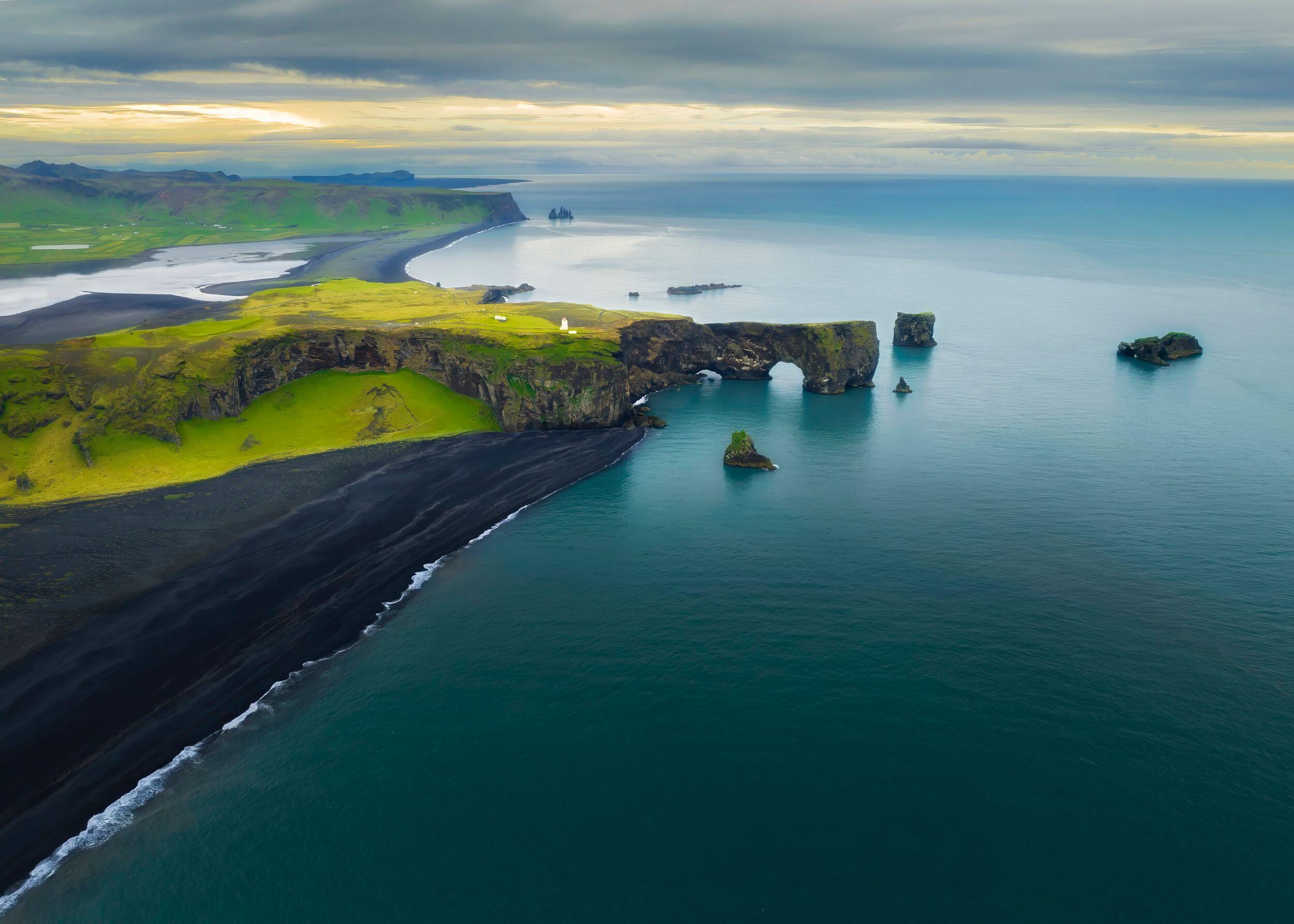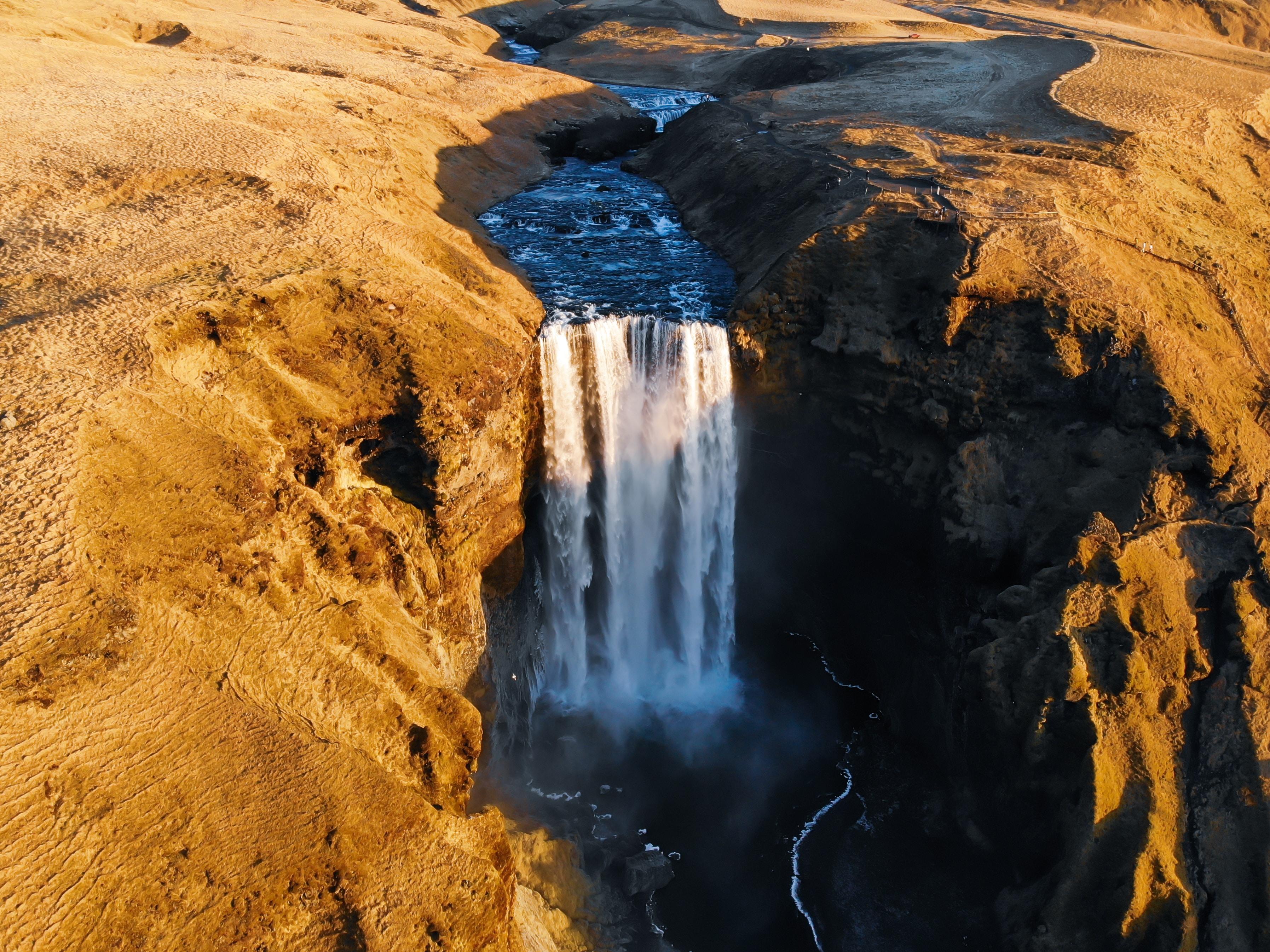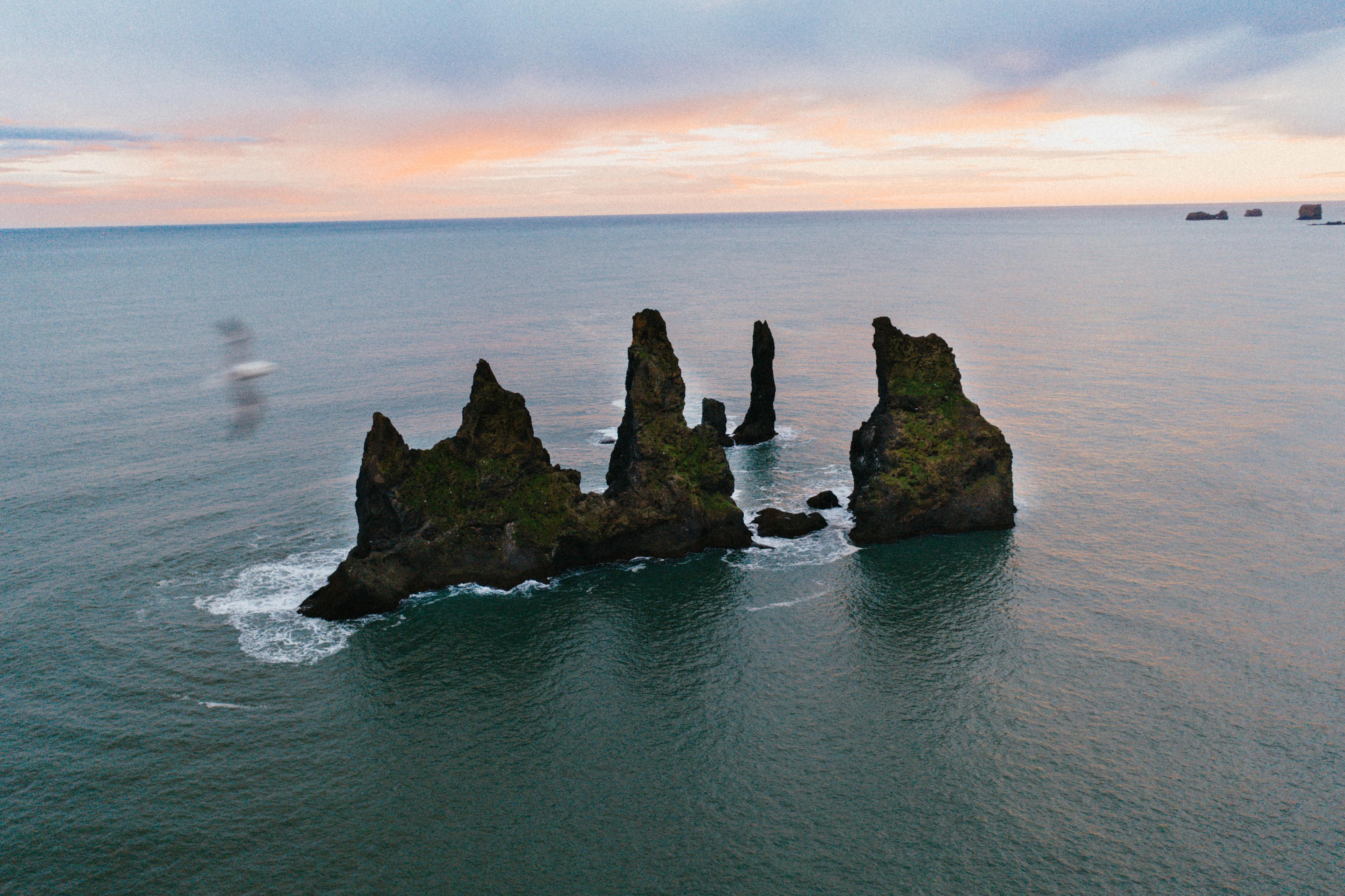
- Best time to visit
- All year round
- Distance from Reykjavík
- 190 km (118 mi)
- Coordinates
- 63.40525, -19.0277
Everything to know about Reynisdrangar before your visit
Reynisdrangar is the name of the mysterious series of sea stacks that emerge from the ocean close to Reynisfjara, on the south coast of Iceland. They’re part of what gives this black-sand beach—voted among the most beautiful in the world—its strange atmosphere and charm.
But what are the Reynisdrangar sea stacks, and how were they formed?
Well, if you believe the legends, these rocks are actually the petrified bodies of trolls. One night, it’s said, trolls were trying to pull a ship out to sea. But they misjudged the time and the sun came up sooner than they expected. As a result, they were immediately turned to stone. Some people say that you can hear these rocks moaning even now, as the trolls yearn to return to the mountains.
It’s a story that captures the magic of this place. But the reality is that these rocks were the product of natural processes that are just as fascinating.
The history of Reynisdrangar
Reynisdrangar is believed to have been formed in a volcanic eruption 18 million years ago. This would have spat hot rock from the land into the sea, where it would have piled up in spectacular cliffs. However, over time, that rock would have been eroded by the continuous crashing of the sea’s waves. Now, as a result, there are only those strange triangular pillars left in the sea.
The distinctive geometric columns that you see in the cliffs on the beach would have been formed in the same process. As the lava from the eruption cooled, these regular columns would have been created. And just like the sea stacks, they would have been eroded over hundreds of thousands of years too.
An interesting question is: what will the Reynisdrangar view look like in future? Like much of Iceland, this is a live landscape that’s being changed by volcanic, glacial, and coastal processes. The Reynisdrangar you see in a hundred years might be very different!
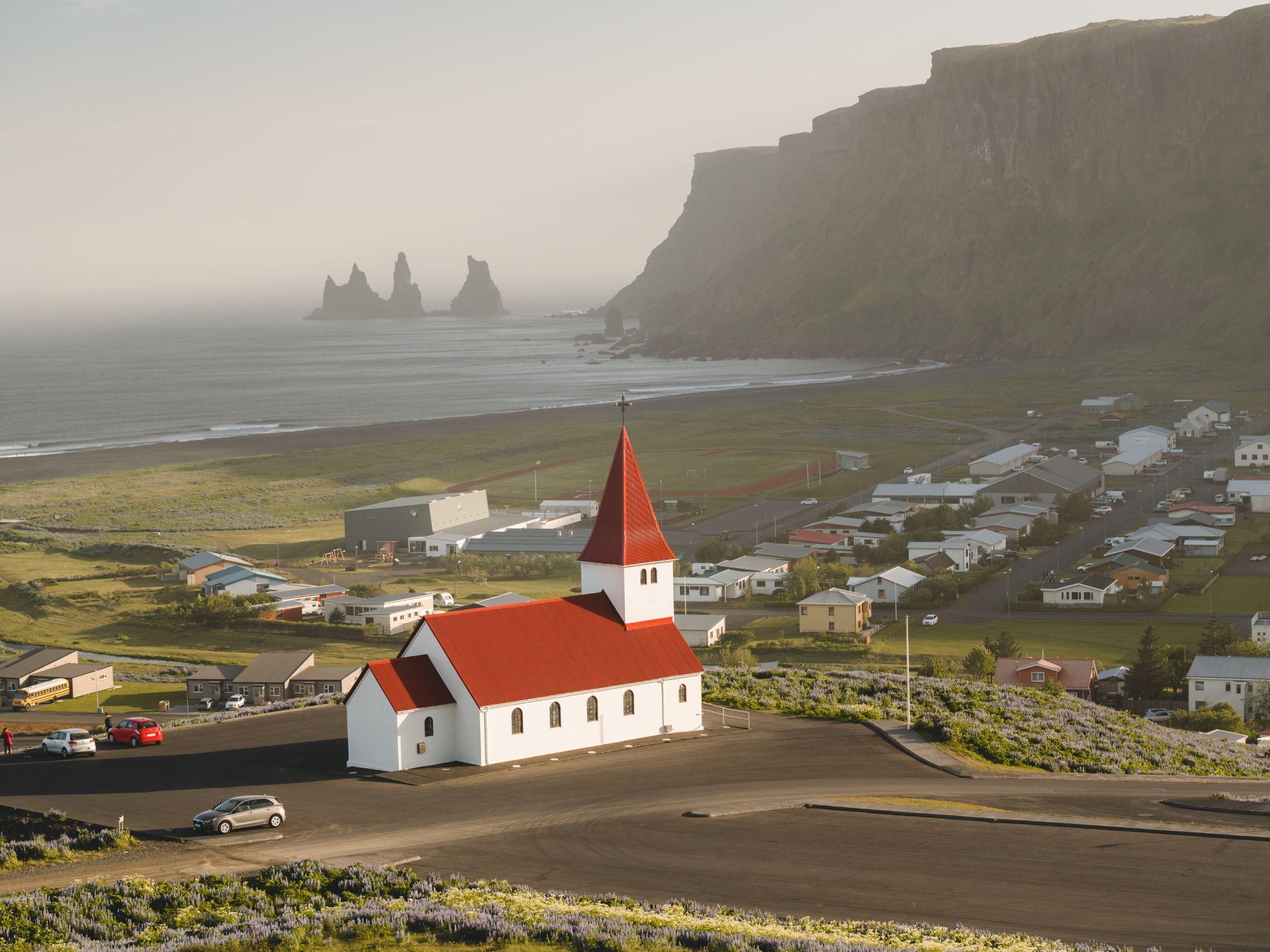
Other sights in the area
Reynisdrangar is in one of the most beautiful areas in Iceland. While you’re here, you should definitely spend time exploring the surrounding region.
Some of the best sights aren’t very far away at all. For example, there’s Reynisfjara beach, from where you will see Reynisdrangar. This black-sand beach is known as one of Iceland’s most beautiful (in fact, it’s often named as one of the most beautiful beaches in the world). With its mysterious sands, gorgeous cliffs, and powerful waves, it’s truly a magical place.
Flanking Reynisfjara is the mountain known as Reynisfjall. At 340 metres (1,115 feet), this mountain towers over both the black-sand beach and the Reynisdrangar basalt columns. If you have the energy, you can climb to the top and enjoy the view from the cliffs. It’s an exceptionally beautiful place, with views over two of the best-known sights in Iceland.
You can also enjoy a view of the Reynisdrangar sea stacks from Dyrhólaey peninsula, the southernmost point in all of mainland Iceland. Here, you’ll find a lighthouse standing over the cliffs, with views east and west over the surrounding coastline.
If you want another perspective on Reynisdrangar, you can get one in Vík, the delightful village where you might well stay the night. From the village’s own black-sand beach, the sea stacks can be seen on the horizon. This is also the best place from which to climb Reynisfjall.
There’s a lot more to do in Vík too. In fact, it’s a popular place to stop along the south coast, with pubs, restaurants, and plenty of accommodation options. While you’re here, visit the Icelandic Lava Show, the only place in the world where you can see lava in a controlled environment.
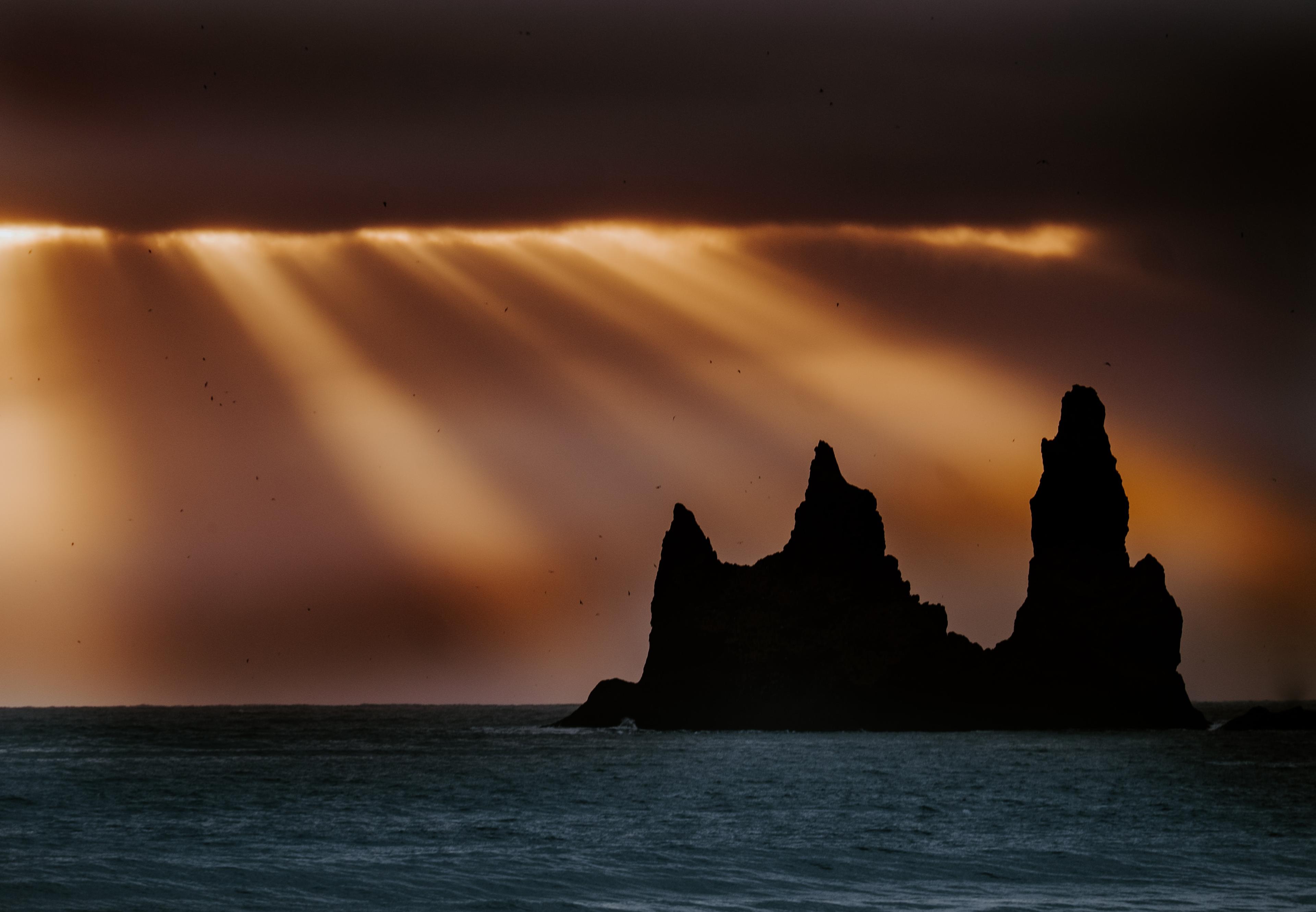
How to visit Reynisdrangar
Reynisdrangar is at the heart of the south coast of Iceland. It’s only a short distance from the village of Vík, one of the most popular stopovers on this coast. Overall, it’s really easy to reach.
If you are coming from Reykjavík, the journey is roughly 190 kilometres (118 miles) to Reynisfjara beach. It should typically take about 2.5 hours one way. If you’re driving, there is a car park that is free of charge right next to the Reynisfjara beach.
But there is a more convenient way to visit: on a tour of the south coast. This way, you’ll see the best of the region without having to drive. And you’ll have the pleasure of meeting like-minded travellers along the way.
Alternatively, you can see Reynisdrangar from Vík itself. For example, take a stroll down to the black-sand beach close to the village, or try the hour-long walk up to the cliffs of Reynisfjall. From both locations, you’ll have a great view of this most breathtaking of geological forms.
Whichever way you visit, it’s worth being aware of basic safety precautions. For example, the sea at Reynisfjara is notoriously wild, with strong waves that can catch you by surprise. All visitors are advised not to turn their back on the sea, nor to get too close. There have been fatalities here.
It’s also smart to be prepared for the weather. Whether you’re climbing up to the top of the Reynisfjall cliffs or just walking along the beach, wear sturdy shoes and a waterproof jacket, at the very least. The weather can change very quickly.
All you need to know about Reynisgrangar
Due to its incredibly striking scenery, the Reynisfjara black sand beach has starred in many different films. For example, it appears in the 2014 film, Noah, and the 2016 film, Rogue One. Parts of the series Game of Thrones were also shot here.
Reynisdrangar means “Reynir’s pillars”, just as Reynisfjara means “Reynir’s beach”. It’s thought that Reynir was a Viking who gave his name to the area.
It’s thought that Reynisdrangar was formed by a volcanic eruption some 18 million years ago. Lava flooded over the cliffs, completely transforming the area.
However, the area wouldn’t have immediately looked like it does today. Instead, the specific forms of Reynisdrangar would have been created by erosion, from the water continually crashing against the rocks. Still, they’ve looked a bit like they do now probably for hundreds of thousands of years.
You are not permitted to take black sand from Iceland. Iceland’s beaches are incredibly special places, but imagine what would happen if every visitor took some sand home as a souvenir!
Please, when you come to Reynisfjara and other Icelandic sights, take only photographs and memories when you leave. This way, there will still be a beautiful beach for every visitor in the future.
Reynisdrangar is the name of the rock formations that can be found around Reynisfjara beach in southern Iceland. Both Reynisdrangar and the beach itself can be found next to the village of Vík í Mýrdal.
The best view of the Reynisdrangar sea stacks is from the Reynisfjall observation deck on the cliffs to the east of Reynisfjara beach. But you can also walk on the beach itself to see the beauty of the cliffs too.
Reynisfjara is as wild as it is beautiful. Please take some important precautions when visiting, otherwise you may put yourself in danger:
- Don’t even think about swimming. The beauty of Reynisfjara is in its wild and rugged drama. Swimming here would be incredibly dangerous.
- Watch out for sneaker waves. These are waves that can sneak up on you with serious speed and strength. Keep an eye on the sea at all times.
- Come prepared with the right gear and clothing. Sturdy shoes, a waterproof jacket, and warm layers are all essential.
- Please don’t climb. Climbing is not permitted on Reynisfjara or on the surrounding cliffs or sea stacks. It can be very dangerous and must be avoided.
It is very dangerous to swim at Reynisfjara.
That’s because the sea here is highly unpredictable. Sneaker waves are common—i.e. rogue waves that are much stronger than typical waves and that can appear to come out of nowhere. Visitors have been knocked off their feet and dragged out to sea. Some of them have died.
So, please don’t swim at Reynisfjara. Apart from being very wild, the sea is also extremely cold.
By far the most famous black-sand beach in Iceland is Reynisfjara. In fact, it’s possibly the most famous black-sand beach in the world. Reynisfjara has been repeatedly celebrated in lists of the most beautiful beaches on the planet.
Don’t miss it on your visit to Iceland. It’s just outside the village of Vík í Mýrdal.
It’s said that Reynisdrangar, the sea stacks at Reynisfjara, were created when trolls tried to drag a ship out to sea. However, when the sun came up, they were turned to stone. It’s sometimes said that you can hear them moaning, as the trolls still long for the mountains.
The cliffs above Reynisfjara are often home to breathtaking birdlife, including puffins, guillemots, and fulmars. You may see seals out to sea, but they won’t come out onto the sand—as they avoid places often visited by humans.
Reynisfjara beach is free to access, and you won’t need to pay for parking either. It’s another great reason to visit.
In a word, no. It’s not permitted to climb the sea stacks at Reynisdrangar. Not only is it very dangerous, but the rock formations are highly protected. Obviously, you’d need to hire a boat to climb them too.
Scrambling is not allowed at all on Reynisfjara in general. There have been fatalities on the beach caused by rogue waves, and it is simply not worth the risk. Please don’t do it.
Reynisfjara is one of the most beautiful places in Iceland. There’s a lot of hype—with the beach repeatedly being voted among the best in the world—but Reynisfjara really deserves all the praise it gets.
With breathtaking basalt columns, glorious sea stacks, and a mysterious atmosphere, it’s a truly unique place. When you get here, we think you’ll agree that it’s worth it.
Related tours
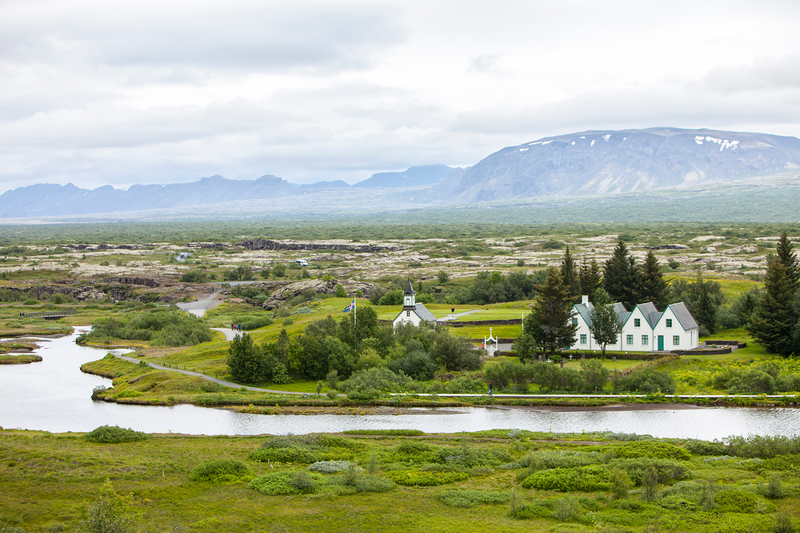
- Multiday Tour
Iceland On a Budget - 5 days
Discover Iceland’s breathtaking landscapes and vibrant capital without stretching your budget on this 5-day (4 nights) Iceland on a Budget package. Experience the country’s most famous sights, including the Golden Circle’s geysers and waterfalls, the dramatic South Coast, and Reykjavík’s best landmarks with a Hop-On Hop-Off city pass. With affordable travel, carbon-neutral transportation, and expert local guides, this package provides an incredible Iceland experience at great value.

South Coast Wonders
This carbon-neutral Iceland South Coast tour is perfect for nature lovers looking to explore Iceland’s top natural attractions in just one day. Visit the stunning Seljalandsfoss and Skógafoss waterfalls, walk along the famous Reynisfjara black sand beach, see the breathtaking Sólheimajökull glacier, and experience the charm of Vík village—and enjoy incredible landscapes along the way.

- Multiday Tour
Iceland On a Budget - 6 days
Experience Iceland’s top sights at great value with this 6-day (5 nights) Iceland on a Budget package. Visit the famous Golden Circle’s geysers and waterfalls, explore the dramatic South Coast’s glaciers and black sand beaches, and uncover Reykjavík’s highlights with a Hop-On Hop-Off city pass. End your journey with a relaxing soak at Hvammsvík Hot Springs, a stunning geothermal retreat in nature. With affordable travel, carbon-neutral transfers, and expert local guides, this package provides an unforgettable adventure without the high costs.

- Multiday Tour
Iceland On a Budget - 7 days
Explore Iceland’s breathtaking landscapes, geothermal hot springs, and volcanic wonders on this 7-day (6 nights) Iceland on a Budget package. See the geysers and waterfalls of the Golden Circle, marvel at the black sand beaches of the South Coast, and discover Reykjavík’s cultural landmarks with a Hop-On Hop-Off city pass. Relax in the serene geothermal pools of Hvammsvík and step inside a real lava tunnel, where you’ll walk through Iceland’s volcanic history. With affordable travel, carbon-neutral transfers, and expert local guides, this package provides a budget-friendly way to experience Iceland’s best sights.


